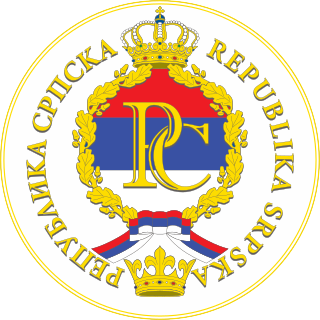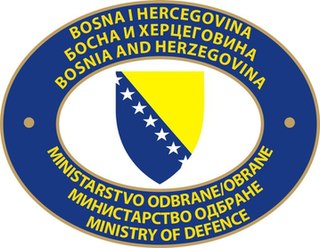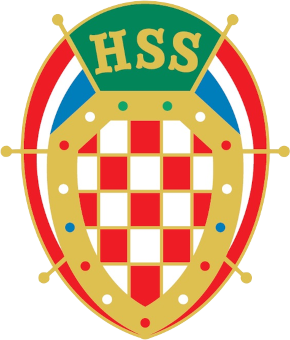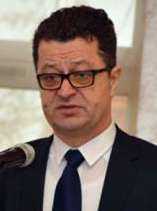Usage
The coat of arms was adopted by the short-lived Croatian Republic of Herzeg-Bosnia in 1992 as a variation of Croatian coat of arms and used throughout the war. It was also present on its military insignia, most notably in Croatian Defence Council (HVO). Entity's vehicle registration plates also sported arms of Herzeg-Bosnia.
Since the entity's incorporation into the Federation of Bosnia and Herzegovina in 1994-6, this Herzeg-Bosnian variation of Croatian chequy has not been officially used on entity or state level. The Federation insignia 1996-2007 included a regular-shaped Croatian chequy, identical to the coat of arms of Croatia without the crown. Such Croatian coat of arms has been used in the Croat components and units in the Federation's and Country's armed forces, too.
However, as a part of the flag of Bosnia's Croats, Herzeg-Bosnian coat of arms is widely present as an unofficial symbol of country's Croats. For example, as a part of the flag it can be found in the office of Croat member of state presidency, [1] [2] as well as in many Croat-majority municipalities and schools in the country. [3] Students’ report cards in secondary schools in Jajce have been marked with the coat of arms of Herzeg-Bosna. [4] Herzeg-Bosnia's coat of arms is a part of the Croatian National Assembly's logo, while its variations are used by some Croat political parties in Bosnia and Herzegovina (most notably, Croatian Party of Rights of Herzeg-Bosnia).
Canton coat of arms
Since the creation of Bosniak-Croat Federation of Bosnia and Herzegovina in 1994 and the establishment of its 10 cantons in 1996, as Herzeg-Bosnia was abolished, its coat of arms was used as the official symbol of three Croat-majority cantons (Posavina Canton, Canton 10 and West Herzegovina Canton). In 1997 and 1998 the Constitutional Court of the Federation of Bosnia and Herzegovina ruled its usage as a canton symbol unconstitutional, since the symbols of cantons and municipalities cannot represent just one ethnic group. [5] [6] Posavina Canton changed its coat of arms in 2000, while it is still used as an official coat of arms of West Herzegovina Canton (since Croats comprise 98,8% of the population) and, controversially, Canton 10 (with 77% of Croats). It is also part of the logo of public companies such as Canton 10's forestry company "Herzeg-Bosnian Forests." [7]

The Federation of Bosnia and Herzegovina is one of the two entities within the State of Bosnia and Herzegovina, the other being Republika Srpska. The Federation of Bosnia and Herzegovina consists of 10 autonomous cantons with their own governments and legislatures.

The coat of arms of Bosnia and Herzegovina was adopted in 1998, replacing the previous design that had been in use since 1992 when Bosnia and Herzegovina gained independence. It follows the design of the national flag. The three pointed shield is used to symbolize the three major ethnic groups of Bosnia, as well as allude to the shape of the country.

The Posavina Canton is one of ten cantons of the Federation of Bosnia and Herzegovina in Bosnia and Herzegovina. It is the smallest canton with an area of only 330.85 km2 (128 sq mi). The canton is an exclave of Federation of Bosnia and Herzegovina, being bordered by Republika Srpska and Brčko District to the south and the river Sava and Croatia to the north. Its capital is Orašje and the largest town is Odžak.

Canton 10 or Herzeg-Bosnian Canton is the largest of the cantons of the Federation of Bosnia and Herzegovina by area and eighth by population. The local government seat is in Livno, while the assembly is in Tomislavgrad.
There is currently no official flag for the Federation of Bosnia and Herzegovina. The federation is part of the state of Bosnia and Herzegovina. The federation adopted its own flag in 1996, but the flag and associated coat of arms were deemed unconstitutional by the Constitutional Court of Bosnia and Herzegovina in 2007. The federation has not yet adopted a new flag, anthem or coat of arms; instead the symbols of the central state are used for official purposes as a provisional solution.

The ten cantons of the Federation of Bosnia and Herzegovina, one of the two political entities of Bosnia and Herzegovina, are its federal units with a high level of autonomy. The cantons were established by the Law on Federal Units (Cantons) on 12 June 1996 as a result of the Washington Agreement of 1994 between the representatives of the Bosnian Croats and Bosniaks.

The West Herzegovina Canton is one of the cantons of the Federation of Bosnia and Herzegovina. The West Herzegovina Canton is in the Herzegovina region in the southwest of Bosnia and Herzegovina. Its seat of government is in Široki Brijeg, while other municipalities within the Canton are Grude, Ljubuški and Posušje. It has 94,898 inhabitants, of whom more than 98% are ethnic Croats.
There is currently no official coat of arms for the Federation of Bosnia and Herzegovina. The federation is part of the state of Bosnia and Herzegovina.

The flag of the abolished Croatian Republic of Herzeg-Bosnia (1992–96) consists of three equal size, horizontal stripes in the pan-Slavic colours arranged in Croat tricolour: red, white and blue. In the middle is the coat of arms of the Croatian Republic of Herzeg-Bosnia stylised with a triple wattle at the top. In 1997 and 1998 the Constitutional Court of the Federation of Bosnia and Herzegovina ruled its usage as a canton flag unconstitutional, since the symbols of cantons and municipalities cannot represent just one ethnic group.

The Croatian Republic of Herzeg-Bosnia was an unrecognized geopolitical entity and quasi-state in Bosnia and Herzegovina. It was proclaimed on 18 November 1991 under the name Croatian Community of Herzeg-Bosnia as a "political, cultural, economic and territorial whole" in the territory of Bosnia and Herzegovina, and abolished on 14 August 1996.

The Croats of Bosnia and Herzegovina, often referred to as Bosnian Croats or Herzegovinian Croats, are the third most populous ethnic group in the country after Bosniaks and Serbs, and are one of the constitutive nations of Bosnia and Herzegovina. Croats of Bosnia and Herzegovina have made significant contributions to the culture of Bosnia and Herzegovina. Most Croats declare themselves Catholics and speakers of the Croatian language.
The Second level basketball leagues in Bosnia and Herzegovina are a 2nd-tier men's professional basketball competitions in Bosnia and Herzegovina. The tier is composed of three regional divisions: the A1 League, the Herzeg-Bosnia League, and the First League of Republika Srpska.

The Seal of Republika Srpska with the description: the flag of Republika Srpska and the Cyrillic letters "РС" ("RS"), the red-blue-white tricolor are in the center of the seal, twisted with the golden Oak leaves, a traditional pre-Christian symbol sacred to most Slavs. On the edge of the seal there is an inscription Republika Srpska. The open crown of Kotromanić is shown in the bottom of the seal and the seal itself is topped with a heraldic royal crown.
Bosnia and Herzegovina vehicle registration plates have held their current form since 2 February 1998. Currently the Bosnia and Herzegovina (BiH) vehicle registration plate format consists of seven characters: five numbers and two letters arranged in the following order: X00-X-000. The plates are uniform across the country and do not denote the place where the vehicle is registered, as was the case prior to 1998. Likewise the plates do not contain any heraldic symbols. The plates use only letters which are represented equally in Latin and Cyrillic script.
JP Elektroprivreda HZHB d.d. is a public power utility company based in Mostar, Bosnia and Herzegovina.

The Ministry of Defence of Bosnia and Herzegovina is the governmental department in charge of the Armed Forces of Bosnia and Herzegovina and protection of Bosnia and Herzegovina from invasion and threats.

Herzegovina is the southern and smaller of two main geographical region of Bosnia and Herzegovina, the other being Bosnia. It has never had strictly defined geographical or cultural-historical borders, nor has it ever been defined as an administrative whole in the geopolitical and economic subdivision of Bosnia and Herzegovina.

The Croatian Peasant Party of Bosnia and Herzegovina is a Croatian political party in Bosnia and Herzegovina.

Martin Raguž is a Bosnian Croat politician who served as the Chairman of the Council of Ministers of Bosnia and Herzegovina from 18 October 2000 until 21 February 2001. He was a member of both the national House of Representatives and House of Peoples.

The Croat federal unit in Bosnia and Herzegovina, or Croat entity, also informally known as the third entity, is a proposed administrative unit in Bosnia and Herzegovina based on territorial federalism and ethnic self-determination. The proposal has been invoked by several political scientists, politicians and political parties, including the Croat National Assembly. So far it has not been discussed beyond the concept level. Since the country is divided into two entities, the Serb-dominated Republika Srpska and the Bosniak-majority Federation, Croats, as one of the three equal constitutive nations, have proposed creating a symmetrical Croat-majority territorial unit. Political advocates for such proposal argue it would ensure Croat equality and prevent electoral gerrymandering, simplify the political gridlock while dismantle overburdening administration. Opponents argue it would further divide the country on ethnic grounds thus breaching the constitutional principles, put non-Croats in a subordinate position, and lead to separatism.
















